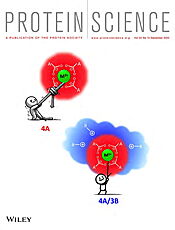Journal:Protein Science:4
From Proteopedia
(Difference between revisions)

| Line 31: | Line 31: | ||
The 4A/3B motif’s metal-binding strength is weaker (~10 kcal/mol) compared to motifs with multiple anionic residues not surrounded by cationic residues. This flexibility without conformational change suggests the motif may act as a metal ion reservoir, potentially regulating metal concentrations or adapting thermal stability. Similar motifs were found in other proteins, indicating a broader functional role beyond TcAChE. | The 4A/3B motif’s metal-binding strength is weaker (~10 kcal/mol) compared to motifs with multiple anionic residues not surrounded by cationic residues. This flexibility without conformational change suggests the motif may act as a metal ion reservoir, potentially regulating metal concentrations or adapting thermal stability. Similar motifs were found in other proteins, indicating a broader functional role beyond TcAChE. | ||
| - | <b>References</b | + | <b>References</b> |
<references/> | <references/> | ||
</StructureSection> | </StructureSection> | ||
__NOEDITSECTION__ | __NOEDITSECTION__ | ||
Revision as of 18:39, 18 November 2024
| |||||||||||
This page complements a publication in scientific journals and is one of the Proteopedia's Interactive 3D Complement pages. For aditional details please see I3DC.

